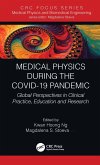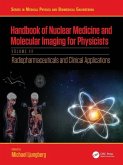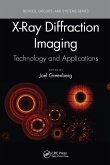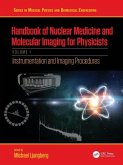Radiotheranostics - A Primer for Medical Physicists I
Physics, Chemistry, Biology and Clinical Applications
Herausgeber: Borrás, Cari; Stabin, Michael G.
Radiotheranostics - A Primer for Medical Physicists I
Physics, Chemistry, Biology and Clinical Applications
Herausgeber: Borrás, Cari; Stabin, Michael G.
- Gebundenes Buch
- Merkliste
- Auf die Merkliste
- Bewerten Bewerten
- Teilen
- Produkt teilen
- Produkterinnerung
- Produkterinnerung
This book covers scientific, clinical, and educational aspects of radiotheranostics in cancer control. Setting the framework, the first volume defines radiotheranostics and describes the history of radionuclide therapy and theranostics, and the biology of cancer.
Andere Kunden interessierten sich auch für
![Medical Physics During the COVID-19 Pandemic Medical Physics During the COVID-19 Pandemic]() Medical Physics During the COVID-19 Pandemic33,99 €
Medical Physics During the COVID-19 Pandemic33,99 €![Handbook of Nuclear Medicine and Molecular Imaging for Physicists Handbook of Nuclear Medicine and Molecular Imaging for Physicists]() Michael LjungbergHandbook of Nuclear Medicine and Molecular Imaging for Physicists69,99 €
Michael LjungbergHandbook of Nuclear Medicine and Molecular Imaging for Physicists69,99 €![X-Ray Diffraction Imaging X-Ray Diffraction Imaging]() X-Ray Diffraction Imaging81,99 €
X-Ray Diffraction Imaging81,99 €![Handbook of Nuclear Medicine and Molecular Imaging for Physicists Handbook of Nuclear Medicine and Molecular Imaging for Physicists]() Handbook of Nuclear Medicine and Molecular Imaging for Physicists69,99 €
Handbook of Nuclear Medicine and Molecular Imaging for Physicists69,99 €![Toxicology-A Primer on Toxicology Principles and Applications Toxicology-A Primer on Toxicology Principles and Applications]() Michael A. KamrinToxicology-A Primer on Toxicology Principles and Applications248,99 €
Michael A. KamrinToxicology-A Primer on Toxicology Principles and Applications248,99 €![Medical Physics During the COVID-19 Pandemic Medical Physics During the COVID-19 Pandemic]() Medical Physics During the COVID-19 Pandemic74,99 €
Medical Physics During the COVID-19 Pandemic74,99 €![The Slit Lamp Primer The Slit Lamp Primer]() Janice K. LedfordThe Slit Lamp Primer88,99 €
Janice K. LedfordThe Slit Lamp Primer88,99 €-
-
-
This book covers scientific, clinical, and educational aspects of radiotheranostics in cancer control. Setting the framework, the first volume defines radiotheranostics and describes the history of radionuclide therapy and theranostics, and the biology of cancer.
Hinweis: Dieser Artikel kann nur an eine deutsche Lieferadresse ausgeliefert werden.
Hinweis: Dieser Artikel kann nur an eine deutsche Lieferadresse ausgeliefert werden.
Produktdetails
- Produktdetails
- Verlag: CRC Press
- Seitenzahl: 230
- Erscheinungstermin: 20. Februar 2024
- Englisch
- Abmessung: 260mm x 183mm x 17mm
- Gewicht: 636g
- ISBN-13: 9781032138978
- ISBN-10: 1032138971
- Artikelnr.: 69433479
- Herstellerkennzeichnung
- Libri GmbH
- Europaallee 1
- 36244 Bad Hersfeld
- gpsr@libri.de
- Verlag: CRC Press
- Seitenzahl: 230
- Erscheinungstermin: 20. Februar 2024
- Englisch
- Abmessung: 260mm x 183mm x 17mm
- Gewicht: 636g
- ISBN-13: 9781032138978
- ISBN-10: 1032138971
- Artikelnr.: 69433479
- Herstellerkennzeichnung
- Libri GmbH
- Europaallee 1
- 36244 Bad Hersfeld
- gpsr@libri.de
Cari (Caridad) Borrás is a certified medical physicist in Washington, DC, USA, where she works as an international consultant and has an adjunct faculty position at the George Washington University School of Medicine and Health Sciences. She obtained a Doctor of Science (Physics) degree from the University of Barcelona, Spain, having done a thesis research project on the dosimetry and embryological effects of Astatine- 211 at Thomas Jefferson University in Philadelphia, PA, USA, as a Fulbright scholar. She has lectured in more than 300 seminars/courses/congresses, many organized by her; authored/contributed around 100 articles and six book chapters and edited two books. She is a Fellow of ACR, AAPM, IOMP, HPS, and IUPESM, and has received awards/recognitions from SEFM, AAPM, IOMP, ALFIM, ACCE, ACR, and ABR. Michael G. Stabin is a Certified Health Physicist, President of the Radiation Dose Assessment Resource, Inc., living in Kennewick, WA, USA, where he worked for NV5 - Technical Engineering & Consulting Solutions and Hanford Mission Integration Solutions. He was an Associate Professor in the Radiology and Radiological Sciences Department at Vanderbilt University, in Nashville, TN, and a Scientist at the Radiation Internal Dose Information Center of Oak Ridge Institute for Science and Education. He received a Ph.D. in Nuclear Engineering (Health Physics emphasis) from the University of Tennessee, is a member of the HPS and the SNMMI, and is also a Fulbright scholar. He has over 225 publications in the open literature, most on internal dosimetry for nuclear medicine applications, including complete textbooks on health physics and internal dose assessment.
Section I: Introduction. Chapter 1: What is radiotheranostics? Chapter 2:
History of radionuclide therapy and theranostics. Chapter 3: Biological
principles behind targeted radionuclide therapy for cancer. Section II:
Clinical Applications of Targeted Radionuclide Therapy in Cancer Control.
Chapter 4: Unconjugated radionuclides. Chapter 5: Radionuclide-conjugated
cancer-specific vectors: Peptides. Chapter 6: Radionuclide-conjugated
cancer-specific vectors: Small Molecules and antibodies. Chapter 7:
Radionuclide-conjugated cancer-specific vectors: Nanoparticles. Chapter 8:
Introduction to clinical trials and drug development for radionuclide
therapies. Chapter 9: Epidemiologic Studies of Cancer Risk among Patients
Administered Radionuclides. Chapter 10: Adverse effects of radionuclide
therapy. Section III: Radiation Chemistry and Physics. Chapter 11:
Radionuclide production. Chapter 12: Radioactivity measurement and
traceability. Chapter 13: Instrumentation, calibration, quantitative
imaging, and quality control. Section IV: The Future. Chapter 14: Human
resources: Multidisciplinary team education, training, and competence.
Chapter 15: Theranostics today: Looking backwards to tomorrow.
History of radionuclide therapy and theranostics. Chapter 3: Biological
principles behind targeted radionuclide therapy for cancer. Section II:
Clinical Applications of Targeted Radionuclide Therapy in Cancer Control.
Chapter 4: Unconjugated radionuclides. Chapter 5: Radionuclide-conjugated
cancer-specific vectors: Peptides. Chapter 6: Radionuclide-conjugated
cancer-specific vectors: Small Molecules and antibodies. Chapter 7:
Radionuclide-conjugated cancer-specific vectors: Nanoparticles. Chapter 8:
Introduction to clinical trials and drug development for radionuclide
therapies. Chapter 9: Epidemiologic Studies of Cancer Risk among Patients
Administered Radionuclides. Chapter 10: Adverse effects of radionuclide
therapy. Section III: Radiation Chemistry and Physics. Chapter 11:
Radionuclide production. Chapter 12: Radioactivity measurement and
traceability. Chapter 13: Instrumentation, calibration, quantitative
imaging, and quality control. Section IV: The Future. Chapter 14: Human
resources: Multidisciplinary team education, training, and competence.
Chapter 15: Theranostics today: Looking backwards to tomorrow.
Section I: Introduction. Chapter 1: What is radiotheranostics? Chapter 2:
History of radionuclide therapy and theranostics. Chapter 3: Biological
principles behind targeted radionuclide therapy for cancer. Section II:
Clinical Applications of Targeted Radionuclide Therapy in Cancer Control.
Chapter 4: Unconjugated radionuclides. Chapter 5: Radionuclide-conjugated
cancer-specific vectors: Peptides. Chapter 6: Radionuclide-conjugated
cancer-specific vectors: Small Molecules and antibodies. Chapter 7:
Radionuclide-conjugated cancer-specific vectors: Nanoparticles. Chapter 8:
Introduction to clinical trials and drug development for radionuclide
therapies. Chapter 9: Epidemiologic Studies of Cancer Risk among Patients
Administered Radionuclides. Chapter 10: Adverse effects of radionuclide
therapy. Section III: Radiation Chemistry and Physics. Chapter 11:
Radionuclide production. Chapter 12: Radioactivity measurement and
traceability. Chapter 13: Instrumentation, calibration, quantitative
imaging, and quality control. Section IV: The Future. Chapter 14: Human
resources: Multidisciplinary team education, training, and competence.
Chapter 15: Theranostics today: Looking backwards to tomorrow.
History of radionuclide therapy and theranostics. Chapter 3: Biological
principles behind targeted radionuclide therapy for cancer. Section II:
Clinical Applications of Targeted Radionuclide Therapy in Cancer Control.
Chapter 4: Unconjugated radionuclides. Chapter 5: Radionuclide-conjugated
cancer-specific vectors: Peptides. Chapter 6: Radionuclide-conjugated
cancer-specific vectors: Small Molecules and antibodies. Chapter 7:
Radionuclide-conjugated cancer-specific vectors: Nanoparticles. Chapter 8:
Introduction to clinical trials and drug development for radionuclide
therapies. Chapter 9: Epidemiologic Studies of Cancer Risk among Patients
Administered Radionuclides. Chapter 10: Adverse effects of radionuclide
therapy. Section III: Radiation Chemistry and Physics. Chapter 11:
Radionuclide production. Chapter 12: Radioactivity measurement and
traceability. Chapter 13: Instrumentation, calibration, quantitative
imaging, and quality control. Section IV: The Future. Chapter 14: Human
resources: Multidisciplinary team education, training, and competence.
Chapter 15: Theranostics today: Looking backwards to tomorrow.








